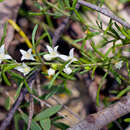en
names in breadcrumbs


Cyanothamnus inflexus is a plant in the citrus family Rutaceae and is endemic to tablelands near the New South Wales - Queensland border in Australia. It is an erect, woody shrub with pinnate leaves and up to seven white to pink four-petalled flowers in the leaf axils. Boronia bipinnata is similar but has larger, bipinnate or tripinnate leaves and smaller sepals and petals.
Cyanothamnus inflexus is an erect, woody shrub that grows to a height of about 2 m (7 ft) and a width of about 3 m (10 ft). The leaves are pinnate, 6–25 mm (0.2–1 in) long and 6–35 mm (0.2–1 in) wide in outline on a petiole 3–10 mm (0.1–0.4 in) long. The end leaflet is linear, 1–16 mm (0.04–0.6 in) long and 0.5–2.5 mm (0.02–0.1 in) wide, the side leaflets similar or longer. Up to three, sometimes up to seven white to pink flowers are arranged on a stalk 0.5–9 mm (0.020–0.35 in) long. The four sepals are triangular, mostly glabrous, 1.5–3 mm (0.059–0.12 in) long and 1–2 mm (0.039–0.079 in) wide. The four petals are 2.5–7.5 mm (0.098–0.30 in) long, sometimes with a few hairs. The eight stamens are hairy and the stigma is about the same width as the style. Flowering occurs from June to December and the fruit are 3–3.5 mm (0.12–0.14 in) long and 1–2 mm (0.039–0.079 in) wide.[2][3][4]
This species was first formally described in 2003 by Marco F. Duretto and the description was published in the journal Muelleria from a specimen collected in the Girraween National Park.[5] In a 2013 paper in the journal Taxon, Marco Duretto and others changed the name to Cyanothamnus inflexus on the basis of cladistic analysis.[6] The specific epithet (inflexus) is a Latin word referring to the edges of the sepals, near their tip.[2]
In the same 2003 paper, Duretto described four new subspecies.[2] The names have subsequently been changed to reflect the change in the genus name:
Cyanothamnus inflexus grows in heath, woodland and forest on granite and in soils derived from granite. Subspecies inflexus occurs between Stanthorpe and the Girraween National Park and disjunctly in the Gibraltar Range National Park and subspecies on a small hill near Applethorpe north of Stanthorpe. Subspecies grandiflorus occurs near Amiens and Lyra and subspecies torringtonensis is restricted to the Torrington area in New South Wales.[2][4]
Cyanothamnus inflexus subsp. montiazureus (as Boronia inflexa subsp. montiazura is classed as "least concern" under the Queensland Government Nature Conservation Act 1992.[10]
Cyanothamnus inflexus is a plant in the citrus family Rutaceae and is endemic to tablelands near the New South Wales - Queensland border in Australia. It is an erect, woody shrub with pinnate leaves and up to seven white to pink four-petalled flowers in the leaf axils. Boronia bipinnata is similar but has larger, bipinnate or tripinnate leaves and smaller sepals and petals.